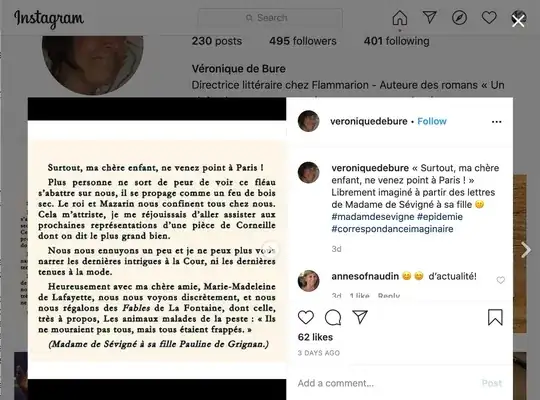According to this webpage, Madame de Sévigné wrote the following letter to her daughter (Madame de Grignan).
Surtout, ma chère enfant, ne venez point à Paris !
Plus personne ne sort de peur de voir ce fléau s’abattre sur nous, il se propage comme un feu de bois sec. Le roi et Mazarin nous confinent tous dans nos appartements.
Monsieur Vatel, qui reçoit ses charges de marée, pourvoie à nos repas qu'il nous fait livrer,
Cela m’attriste, je me réjouissais d’aller assister aux prochaines représentations d’une comédie de Monsieur Corneille "Le Menteur", dont on dit le plus grand bien.
Nous nous ennuyons un peu et je ne peux plus vous narrer les dernières intrigues à la Cour, ni les dernières tenues à la mode.Heureusement, je vois discrètement ma chère amie, Marie-Madeleine de Lafayette, nous nous régalons avec les Fables de Monsieur de La Fontaine, dont celle, très à propos, « Les animaux malades de la peste » ! « Ils ne mouraient pas tous, mais tous étaient frappés ».
Je vous envoie deux drôles de masques ; c’est la grand'mode. tout le monde en porte à Versailles. C’est un joli air de propreté, qui empêche de se contaminer,
Je vous embrasse, ma bonne, ainsi que Pauline.
which Google Translate translates as:
Above all, my dear child, do not come to Paris!
No one goes out for fear of seeing this plague fall on us, it spreads like a fire in dry wood. The king and Mazarin confine us all in our apartments.
Mr. Vatel, who receives his tide loads, provides our meals which he has delivered to us,
It saddens me, I was excited to attend the upcoming performances of a comedy by Monsieur Corneille "The Liar", of which they say the best things. We are bored a bit and I can no longer tell you about the latest court intrigues, or the latest fashionable outfits.Fortunately, I discreetly see my dear friend, Marie-Madeleine de Lafayette, we are enjoying the Fables of Monsieur de La Fontaine, including very aptly "The animals sick of the plague"! "Not all of them died, but all were struck."
I send you two funny masks; this is the great fashion. Everyone wears them in Versailles. It’s a nice air of cleanliness, which prevents contamination.
I kiss you, my dear, as well as Pauline.
The punctuation is incorrect, which makes me feel like the original letter might be different. Also, the letter is strangely similar to the lockdown measures in response to Covid-19 today. Is the letter real? Is the entire letter as written originally?
